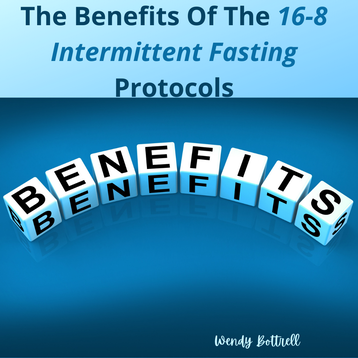The 16-8 Intermittent Fasting Protocol Our conversation today will include the benefits of the 16-8 intermittent fasting protocol. This is how we have chosen to practice IF for the past year. It has been simple to do because we just calculate the time between dinner and the first meal for the following day. Yesterday we wrote on A Simple Introduction To Intermittent Fasting - What You Need To know https://wendybottrell.weebly.com/blog/a-simple-introduction-to-intermittent-fasting-what-you-need-to-know Check out the benefits of this fasting protocol When we began this practice last year we heard this - If there was one intermittent fasting protocol that most people tend to try first, it is probably the 16-8 protocol. Also called Lean Gains, the 16-8 fasting protocol is good for beginners because you don’t go as long in between eating periods. Many people struggle with IF which requires going 24 hours or longer without eating or drinking anything, so this can be a good one to start with. Benefits of the 16-8 Protocol Ease of following this protocol is one of the main benefits. You aren’t having to go 24 hours between meals, which can be very hard for some people. This is what is involved in the Warrior Diet or the Eat-Stop-Eat method of intermittent fasting. With the LeanGains, or 16-8, you are only going 16 hours without eating. Keep in mind a lot of this is while you are sleeping, so there are just a few hours in the morning and a few hours in the evening where you are not eating while awake. You can also reduce your hunger as your body becomes accustomed to the protocol, and burn all the stubborn fat your body has been holding onto. Don’t forget the convenience of only eating 8 hours out of the day, instead of trying to plan and schedule meals every few hours. Here is some additional good information and ideas for the 16-8 protocol from Mindbodygreen.com - https://www.mindbodygreen.com/articles/16-8-intermittent-fasting-schedule How to do the 16-8 Protocol This is one of the simplest intermittent fasting protocols, which is why it also happens to be one of the most popular. If you think about it, going 16 hours without eating really isn’t a huge stretch. Think about the weekends when you plan to go to brunch at lunchtime; you probably don’t’ eat until noon or 1 in the afternoon. Depending on when you ate the night before, this might easily be 16 hours later or longer. Y ou just need to schedule your meals accordingly so that you eat for 8 hours, then fast for the next 16, and repeat. Tips for Doing the 16-8 Fasting Protocol If you’re new to intermittent fasting or just this protocol, here are some tips that can help: Consider fasting more in the morning – With an 8-hour eating window, you can choose to schedule it during any time, then fast for the following 16 hours. If you tend to munch at night or like going out with friends in the evenings, you might be better off starting fasting late, then skipping breakfast and eating a late lunch the following day. Skip all calories – While you should definitely have water during the fasting hours, and you can have coffee and tea, skip everything with calories. This includes creamer in your coffee and Bulletproof coffee. If you are feeling faint or ill, or just like flavoured coffee, a little creamer or cup of broth won’t hurt you, but it really is better to stick to no calories. Make sure you give your body time to adjust. The 16 hours of fasting might be difficult for the first few days, but you will get used to it. Soon, you won’t even get hungry until those eating windows. Now, when I first started the practice of fasting, I didn’t want to feel so stressed about the beginning. I made the choice in the beginning if I felt really hunger, I would push myself to do the 16 hours fast, however, if I got feeling too stressed, I would eat. And I would then begin to notice why I was feeling especially hungry on that day. Was I more stressed? How was my sleep? What did I have for dinner? This helped me stick with the fasting protocol in the beginning. A year later I have noticed that I don’t even think about eating first thing in the morning now. I go out for my walk each morning fasted and it feels good. Most days I just walk however there are a couple of days a week where I might do some short spurt runs over my hour walk. But when you are starting Intermittent fasting practice. Start with 12 hours and work up to 16 hours. The benefits will come in the consistent practice of intermittent fasting, at least this has been my experience. Your feedback is invaluable! We'd love to hear from you! Share your thoughts, ideas, or comments below, and let's continue to inspire each other on our paths to wellness. If you ever need guidance or support, don't hesitate to reach out. We're here to help you thrive every step of the way. Let's Build Health & Fitness - Join Our Newsletter Today & Receive the FREE Beginners Guide To Healthy Eating! Sign Up Today! https://bit.ly/42Hf0aR
0 Comments
Leave a Reply. |
Archives
April 2024
Categories |










 RSS Feed
RSS Feed
